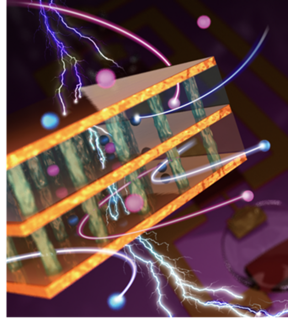Home > Press > Vertical electrochemical transistor pushes wearable electronics forward: Biomedical sensing is one application of efficient, low-cost transistors
 |
| The vertical electrochemical transistor is based on a new kind of electronic polymer and a vertical, instead of planar, architecture.
CREDIT Northwestern University |
Abstract:
A transdisciplinary Northwestern University research team has developed a revolutionary transistor that is expected be ideal for lightweight, flexible, high-performance bioelectronics.
Vertical electrochemical transistor pushes wearable electronics forward: Biomedical sensing is one application of efficient, low-cost transistors
Evanston, IL | Posted on January 20th, 2023
The electrochemical transistor is compatible with blood and water and can amplify important signals, making it especially useful for biomedical sensing. Such a transistor could enable wearable devices for onsite signal processing, right at the biology-device interface. Potential applications include measuring heartbeat and levels of sodium and potassium in blood as well as eye motion for studying sleep disorders.
All modern electronics use transistors, which rapidly turn current on and off, said Tobin J. Marks, a co-corresponding author of the study. Here we use chemistry to enhance the switching. Our electrochemical transistor takes performance to a totally new level. You have all the properties of a conventional transistor but far higher transconductance (a measure of the amplification it can deliver), ultra-stable cycling of the switching properties, a small footprint that can enable high density integration, and easy, low-cost fabrication.
Marks is a world leader in the fields of materials science and organic electronics. He is the Vladimir N. Ipatieff Professor of Catalytic Chemistry in the Weinberg College of Arts and Sciences and professor of materials science and engineering and chemical and biological engineering in the McCormick School of Engineering.
The vertical electrochemical transistor is based on a new kind of electronic polymer and a vertical, instead of planar, architecture. It conducts both electricity and ions and is stable in air. The design and synthesis of new materials and the transistors fabrication and characterization required the collaborative expertise of chemists, materials scientists and biomedical engineers.
Marks led the research team along with Antonio Facchetti, research professor of chemistry at Weinberg; Wei Huang, now a professor at the University of Electronic Science and Technology of China; and Jonathan Rivnay, professor of biomedical engineering at the McCormick School.
This exciting new type of transistor allows us to speak the language of both biological systems, which often communicate via ionic signaling, and electronic systems, which communicate with electrons, Rivnay said. The ability of the transistors to work very efficiently as mixed conductors makes them attractive for bioelectronic diagnostics and therapies.
This study detailing the efficient electrochemical transistor and an accompanying News & Views article were published this week by the journal Nature.
With their vertical architecture, our electrochemical transistors can be stacked one on top of another, Facchetti said. Thus, we can make very dense electrochemical complementary circuits, which is impossible for the conventional planar electrochemical transistors.
To make more reliable and powerful electronic circuits, two types of transistors are needed: p-type transistors that carry positive charges and n-type transistors that carry negative charges. These types of circuits are called complementary circuits. The challenge researchers have faced in the past is that n-type transistors are difficult to build and are typically unstable.
This is the first work to demonstrate electrochemical transistors with similar and very high performance for both types (p+n) electrochemical transistors. This resulted in the fabrication of very efficient electrochemical complementary circuits.
####
For more information, please click here
Contacts:
Media Contact
Megan Fellman
Northwestern University
Office: 847-491-3115
Expert Contacts
Tobin Marks
Northwestern University
Jonathan Rivnay
Northwestern University
Antonio Facchetti
Northwestern University
Copyright © Northwestern University
If you have a comment, please Contact us.
Issuers of news releases, not 7th Wave, Inc. or Nanotechnology Now, are solely responsible for the accuracy of the content.
News and information
![]()
Manufacturing advances bring material back in vogue January 20th, 2023
![]()
Researchers demonstrate co-propagation of quantum and classical signals: Study shows that quantum encryption can be implemented in existing fiber networks January 20th, 2023
![]()
Approaching the terahertz regime: Room temperature quantum magnets switch states trillions of times per second January 20th, 2023
Wearable electronics
![]()
Tin selenide nanosheets enables to develop wearable tracking devices December 9th, 2022
![]()
Underwater movement sensor alerts when a swimmer might be drowning October 7th, 2022
![]()
Disposable electronics on a simple sheet of paper October 7th, 2022
![]()
Researchers design new inks for 3D-printable wearable bioelectronics: Potential uses include printing electronic tattoos for medical tracking applications August 19th, 2022
Govt.-Legislation/Regulation/Funding/Policy
![]()
Polymer p-doping improves perovskite solar cell stability January 20th, 2023
![]()
Approaching the terahertz regime: Room temperature quantum magnets switch states trillions of times per second January 20th, 2023
![]()
Lithium-sulfur batteries are one step closer to powering the future January 6th, 2023
Possible Futures
![]()
Polymer p-doping improves perovskite solar cell stability January 20th, 2023
![]()
Approaching the terahertz regime: Room temperature quantum magnets switch states trillions of times per second January 20th, 2023
![]()
Correlated rattling atomic chains reduce thermal conductivity of materials January 20th, 2023
Chip Technology
![]()
Manufacturing advances bring material back in vogue January 20th, 2023
![]()
Approaching the terahertz regime: Room temperature quantum magnets switch states trillions of times per second January 20th, 2023
Announcements
![]()
Manufacturing advances bring material back in vogue January 20th, 2023
![]()
Researchers demonstrate co-propagation of quantum and classical signals: Study shows that quantum encryption can be implemented in existing fiber networks January 20th, 2023
Interviews/Book Reviews/Essays/Reports/Podcasts/Journals/White papers/Posters
![]()
Manufacturing advances bring material back in vogue January 20th, 2023
![]()
Researchers demonstrate co-propagation of quantum and classical signals: Study shows that quantum encryption can be implemented in existing fiber networks January 20th, 2023
![]()
Approaching the terahertz regime: Room temperature quantum magnets switch states trillions of times per second January 20th, 2023
Military
![]()
Rice turns asphaltene into graphene for composites: Flashed byproduct of crude oil could bolster materials, polymer inks November 18th, 2022
![]()
How 2D materials expand: New technique that accurately measures how atom-thin materials expand when heated could help engineers develop faster, more powerful electronic devices November 18th, 2022










